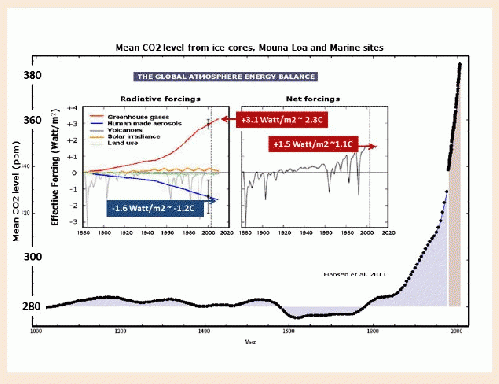Introduction
This
article suggests that the current atmospheric CO2 level is already
triggering amplifying feedbacks from the Earth system and therefore, in
themselves, efforts at reduction in atmospheric CO2-emission are no
longer sufficient to prevent further global warming. For this reason, along
with sharp reductions in carbon emissions, efforts need to be undertaken in an
attempt to reduce atmospheric CO2 levels from their current level of
near-400 ppm to well below 350 ppm. NASA-applied outer space-shade technology
may buy time for such planetary defense effort.
The scale and rate of modern climate change have been greatly underestimated. The release to date of a total of over 560 billion ton of carbon through emissions from industrial and transport sources, land clearing and fires, has raised CO2 levels from about 280 parts per million (ppm) in pre-industrial periods to 397-400 ppm and near 470 ppm CO2-equivalent (a value which includes the CO2-equivalent effect of methane), reaching a current CO2 growth rate of about 2 ppm per year ( http://www.ipcc.ch/ ; http://www.globalcarbonproject.org/ http://www.planetunderpressure2012.net/ ) (see Figures 1 and 2).
Figure 1. Part A. Mean CO2 level from ice cores, Mouna Loa observatory and marine sites; Part B (inset). Climate forcing 1880 -- 2003 ( http://pubs.giss.nasa.gov/abs/ha06510a.html ) . Aerosol forcing includes all aerosol effects, including indirect effects on clouds and snow albedo. GHGs include ozone (O3) and stratospheric H2O, in addition to well-mixed greenhouse gases ( www.atmos-chem-phys.net/11/13421/2011/acp-11-13421-2011.pdf )
These developments are shifting the Earth's climate toward Pliocene-like (5.2 -- 2.6 million years-ago; mean global temperatures of +2-3oC above pre-industrial temperatures) and possibly toward mid-Miocene-like (approximately 16 million years-ago; mean global temperatures +4oC above pre-industrial temperatures) conditions (cmbc.ucsd.edu/content/1/docs/zachos-2001.pdf ; http://www.nature.com/ngeo/journal/v4/n7/fig_tab/ngeo1186_ft.html ) within a few centuries"-a geological blink of an eye.
The current CO 2 level generates amplifying feedbacks, including the reduced capacity of warming water to absorb CO 2 from the atmosphere, CO 2 released from fires, droughts, loss of vegetation cover, disintegration of methane released from bogs, permafrost and methane-bearing ice particles and methane-water molecules.
With CO2 atmospheric
residence times in the order of thousands to tens of thousands years (http://www.pnas.org/content/early/2009/01/28/0812721106.abstract ; geosci.uchicago.edu/~archer/reprints/eby.2009.long_tail.pdf ) , protracted reduction in emissions, either
flowing from human decision or due to reduced economic activity in an
environmentally stressed world, may no longer be sufficient to arrest the
feedbacks.
Four of the large mass
extinction of species events in the history of Earth (end-Devonian,
Permian-Triassic, end-Triassic, K-T boundary) have been associated with rapid
perturbations of the carbon, oxygen and sulphur cycles, on which the biosphere
depends, at rates to which species could not adapt (http://www.amazon.com/Under-Green-Sky-Warming-Extinctions/dp/B002ECEGFC#readerB002ECEGFC; http://theconversation.edu.au/is-another-mass-extinction-event-on-the-way-5397; http://web.mit.edu/newsoffice/2011/mass-extinction-1118.html).

Figure 2.
Relations between CO2
rise rates and mean global temperature rise rates during warming periods,
including the Paleocene-Eocene Thermal Maximum, Oligocene, Miocene, glacial
terminations, Dansgaard-Oeschger cycles and the post-1750 period. (cci.anu.edu.au/files/download/?id=4951 )
Since the 18th century, and in particular since about 1975, the Earth system has been shifting away from Holocene (approximately 10,000 years to the pre-industrial time) conditions, which allowed agriculture, previously hindered by instabilities in the climate and by extreme weather events. The shift is most clearly manifested by the loss of polar ice (click here). Sea level rises have been accelerating, with a total of more than 20 cm since 1880 and about 6 cm since 1990 ( http://www.eea.europa.eu/data-and-maps/indicators/sea-level-rise-1/assessment ).
(Note: You can view every article as one long page if you sign up as an Advocate Member, or higher).





